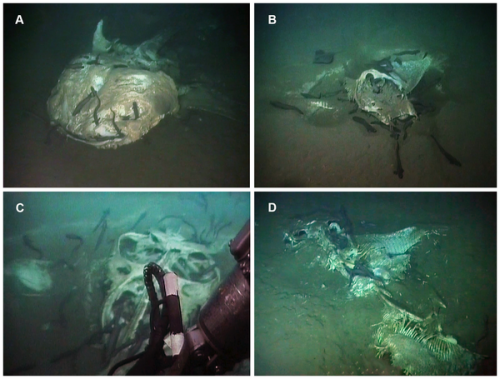May 16, 2014 report
Oil searchers discover and record deep-sea graveyard off Angola coast

A team of researchers looking for oil and gas deposits beneath the seafloor off the western coast of southern Africa has found four large "fish-falls" on the seabed: the carcasses of one whale shark and three mobulid rays. Finding vertebrate carcasses on the seafloor is quite rare, ocean scientists Nicholas Higgs, Andrew Gates and Daniel Jones report in their paper on the discovery published in PLoS ONE—the "graveyard" offers a unique opportunity to learn more about how the death of large sea creatures and the food they provide to other smaller creatures impacts marine life in general.
To date, just nine vertebrate carcasses have ever been found and studied on the deep ocean floor—this recent discovery pushes that number to thirteen. Such carcass remains are categorized by "fall" type. These four were all fish falls, other's such as whale falls generally attract more attention.
Recorded along with the carcasses were scavengers that had arrived at the scene to feast on the large creatures' remains. The researchers note that quite often the first to arrive at a fall of any sort are sharks, though they rarely consume what has been found. Next to find the carcasses are usually crabs and amphipods and at some point osedax that feed on the bones. In the footage the researchers were able to see large numbers of fish surrounding the carcasses, the majority of which were eel pouts, which don't eat carcass remains, but instead feed on other fish that do. The researchers noted that no evidence of osedax were present which suggested that the carcasses hadn't been on the sea floor very long, perhaps just a month or two.
More information: Higgs ND, Gates AR, Jones DOB (2014) Fish Food in the Deep Sea: Revisiting the Role of Large Food-Falls. PLoS ONE 9(5): e96016. DOI: 10.1371/journal.pone.0096016
Abstract
The carcasses of large pelagic vertebrates that sink to the seafloor represent a bounty of food to the deep-sea benthos, but natural food-falls have been rarely observed. Here were report on the first observations of three large 'fish-falls' on the deep-sea floor: a whale shark (Rhincodon typus) and three mobulid rays (genus Mobula). These observations come from industrial remotely operated vehicle video surveys of the seafloor on the Angola continental margin. The carcasses supported moderate communities of scavenging fish (up to 50 individuals per carcass), mostly from the family Zoarcidae, which appeared to be resident on or around the remains. Based on a global dataset of scavenging rates, we estimate that the elasmobranch carcasses provided food for mobile scavengers over extended time periods from weeks to months. No evidence of whale-fall type communities was observed on or around the carcasses, with the exception of putative sulphide-oxidising bacterial mats that outlined one of the mobulid carcasses. Using best estimates of carcass mass, we calculate that the carcasses reported here represent an average supply of carbon to the local seafloor of 0.4 mg m−2d−1, equivalent to ~4% of the normal particulate organic carbon flux. Rapid flux of high-quality labile organic carbon in fish carcasses increases the transfer efficiency of the biological pump of carbon from the surface oceans to the deep sea. We postulate that these food-falls are the result of a local concentration of large marine vertebrates, linked to the high surface primary productivity in the study area.
Journal information: PLoS ONE
© 2014 Phys.org




















